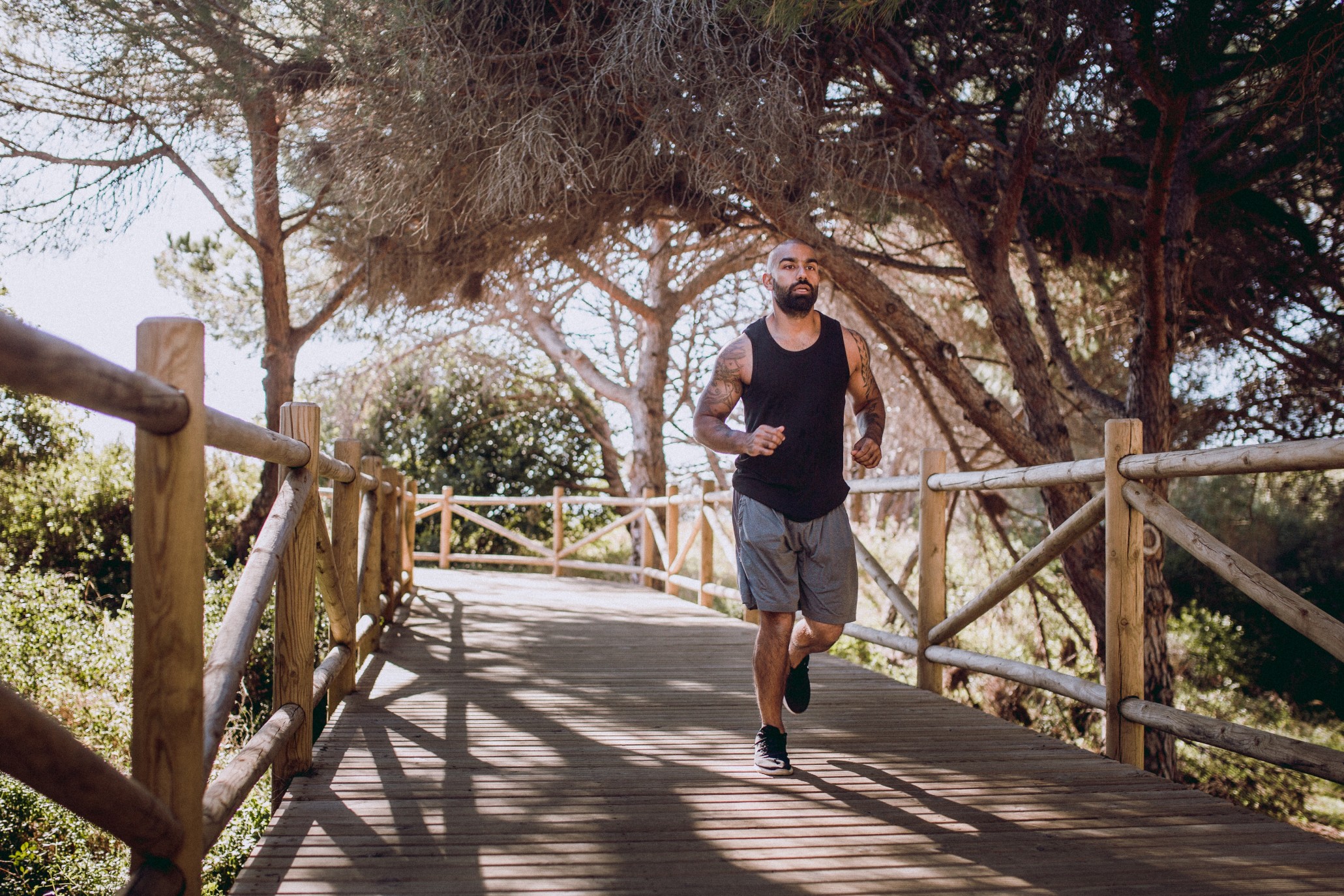Have you ever come across a pair of basketball shoes in your closet that you have not had the occasion to use in a while and thought there might be a similar activity that could bring them out of hiding?
Perhaps you are currently more enthusiastic about running as a form of exercise instead of hitting the courts, and thought maybe you could lace up your basketball shoes and hit the road to save money.
Basketball shoes are not recommended for running because they are heavier and have thinner cushions than running shoes. Running shoes are lightweight and designed specifically for forwarding motion while basketball shoes are made for multi-direction short movements including front, back, side to side movements.
You can certainly run in basketball shoes if you’re doing a short distance, but it is still not an ideal option. You will get tired easier compared to running with running shoes.
On the flip side, you should never play basketball in running shoes, as your chance to get a sprained ankle is Extremely High.
If you are in a school team, it is likely your team will be trained both on the indoor court for skills and outdoor for stamina and agility training. If possible, do not use your basketball shoes outside as they will get worn out very easily, and you will lose grip when you play basketball indoors.
Talk to your parents and invest in budget shoes to abuse outdoors. The best are training shoes for outdoor agility training and running shoes for outdoor stamina building.
In this article, we will explain the categories of basketball and running shoes, compare and contrast the strengths of each and discuss if basketball shoes can be used for shorter distances.
Related: Top 25 Best Basketball Shoes for Guard | Forward | Center
Types of Basketball Shoes | High Top vs Low Top
The type that players choose depends primarily on their playing position on the court, but the different styles also provide varying levels of support that could either help or harm vulnerable areas or old injuries.
High-top basketball shoes: This type of basketball shoes offer the most ankle support and stability, which makes them ideal for players in the center or forward position.
Mid-top basketball shoes: They will empower players to have a wider range of movement while still protecting their ankles. This kind of basketball shoe is well-suited for all-around players, as their biggest strength is versatility.
Low-top basketball shoes: These are best for fast players, empowering them to move more quickly, but this style unfortunately do not offer much ankle protection. These shoes are ideal for a player in the guard position because they provide better mobility and are more lightweight than the other two kinds of basketball shoes.
All of these styles of basketball shoes are heavier than typical running shoes, and they were made to support players instead of runners.
Tip: If you are looking for basketball shoes for heavy players, you need high top basketball shoes with good ankle support.
Great Basketball Shoes for Impact Protection: (heavy players) Lebron 17 Read Review
Understanding Types of Running Shoes

Pronation
Running shoes are built in specific ways to help runners who fall into two different categories: under-pronators and overpronators.
Under-pronation (or supination) means that runners roll their feet outwardly as they run, whereas overpronation means that runners roll their feet inwardly too far.
According to Healthline, approximately 15 degrees of inward pronation is the normal amount.
People with low arches usually overpronate, while people with high arches usually under-pronate, according to UCONN Health Orthopedics and Sports Medicine.
Related: Top 10 Best Running Shoes for High Arches
Thus, there are neutral shoes with extra cushioning to help runners with feet that roll outwardly, and stability shoes or motion control shoes with extra support and padding for runners with feet that roll inwardly.
Stability shoes are for mild overpronation, and they provide additional support for the arch and inner sides of your feet.
Motion control shoes are well-suited for people with flat feet and more severe overpronation, offering rigid portions of plastic or high-density foam to keep your heel from turning out and prevent overpronation.
Because basketball shoes are not made specifically for running, there will not be models that will help runners with a specific ailment.
Related: Basketball shoes for overpronation | Under Armour Anatomix Spawn 2 Review
Drop
Another factor of running shoes to consider if you are thinking of replacing them is the amount of shoe drop.
The difference in heel height from the sometimes thickly padded back part of a shoe to the less padded front is called the drop.
Typical running shoes have a drop of 8–12 mm. A 12 mm drop used to be the standard, but the trend toward minimalist shoes has led to a drop of 8 mm being more common.
If you normally put your weight on your heels while running or you train on hard paved surfaces such as asphalt, a high drop (more than 7 mm) is best.
If you tend to strike first with the front or middle of your foot, a low heel drop (from 0 to 6 mm) is a good choice.
Basketball shoes typically have a drop of approximately 10 mm, which works for people who are prone to heel striking, but it is not ideal for encouraging proper running form or those who have already learned to avoid landing on their heels first.
Running Shoes vs Basketball Shoes
Movements
Basketball shoes are made for side-to-side movements as well as running, whereas running shoes specialize in moving forward.
Basketball shoes are not well-suited for long distance running, and they will cause a large increase in fatigue compared to typical running shoes.
Weight
Running shoes are generally lighter. This is almost always a benefit, but if you are running to lose weight and are carrying more pounds than usual, the extra ankle support and stability plus the added traction of basketball shoes can be helpful.
Support
Basketball shoes support your heels, which is perfect for game-related movements, but not ideal for running, as you should not be striking with your heels.
This hard and flat design also can place additional strain on certain areas of your foot and cause problems in your feet such as plantar fasciitis.
Related: Best Basketball Shoes for Plantar Fasciitis
Soles
Running shoes often have harder soles for use on roads and pavement, whereas indoor basketball shoes have softer soles because they will be used on a smooth court.
Cushioning
Basketball shoes have cushioning that is concentrated in the midfoot area, which makes the sole lighter and better for quick maneuvering.
Running shoes have more cushioning on the heel and forefoot, which helps your body overcome a shock that is roughly equal to two and a half times your bodyweight while running, according to a study in the Clinical Journal of Sports Medicine.
Basketball Shoes are Not Good for Long Runs
They are designed for multi-directional movement, and should be used only for basketball and definitely not for long-distance running.
Related: What Basketball Shoes are Good for Outdoors on Concrete?
Basketball shoes do have a high level of cushioning and shock protection, which your feet and calves need for long-distance runs. They can be used for short runs (less than 10 miles a week), but not long-distance runs.
They also cannot be used outside because it will ruin them for playing on indoor courts, so if you are planning to use basketball shoes for running, they will have to be worn on an indoor track.
If you frequently run in snowy or sandy areas, basketball shoes are not a good choice even for short runs.
Similarly, because it is the hardest, concrete is the worst surface for basketball shoes, as the reduced cushioning in the heel area will cause a large amount of pain in your feet over time.
All in all, it would still be wise to invest in a pair of running shoes. Wearing basketball shoes for both running and basketball might seem more economical, but it increases your risk of injuries.
Therefore raises your chance of an expensive visit to the doctor or hospital and possibly months of physical therapy.
Never Wear Running Shoes to Play Basketball
They are designed for forward motion with absolutely no side to side movement support. Running shoes are simply not recommended to be used for basketball.
Running shoes are not well-suited for basketball because they do not give you enough traction to switch directions quickly.
Their lack of support could also lead to injuries in your ankles and knees. Most NBA players also wear high-top basketball shoes, which offer roughly double the amount of support and stability that typical running shoes provide.
When you land, you will notice the increase in the level of impact if you are wearing running shoes.
Are Basketball Shoes Good for Walking?

You can also use basketball shoes for walking, but it won’t be as ideal as using walking shoes. When you are going for a walk, you’re not looking for the performance that basketball shoes and running shoes offer.
The attributes that you need from walking shoes are:
- Comfort Level
- Lightweight
- Breathability
There are lighter-weight basketball shoes, but most basketball shoes were designed to give traction and protection, not comfortable and breathability.
There is a reason why shoe companies make “Walking Shoes”, specifically for walking. Check out our recommended walking shoes below:
Related: Top 25 Best Walking Shoes | The Most Comfortable Shoes
While basketball shoes might seem similar enough to running shoes to be used interchangeably, there are enough differences to make having a pair of shoes specific to each activity a wiser choice.
To summarize, here are a few of the main points we have discussed in this article:
- Basketball shoes come in three varieties (high-top, mid-top and low-top) that are made with specific playing positions in mind.
- Likewise, running shoes are designed to help correct and support the form of runners by alleviating overpronation or under-pronation, with different levels of drop depending on the striking pattern of the runners.
- Basketball shoes are too heavy to be used for long-distance running, and if they are made for indoor courts, they cannot be used outside.
- Basketball shoes do not have enough cushioning for your heel to support you during long runs.
- Running shoes are lighter and have more shock absorption and harder soles for outdoor running.
- Running shoes should never be worn for basketball.
- Basketball shoes can possibly be used while running less than 10 miles a week on indoor tracks, but it is not highly recommended.
Also Read: What Shoes to Wear for Track and Field?

Austin is the author of loveatfirstfit.com and a personal trainer with extensive knowledge in nutrition. Austin is passionate about helping others to find a suitable healthy lifestyle and feel good about themselves. Austin’s goal is to help people push their limits and achieve their physical performance.

